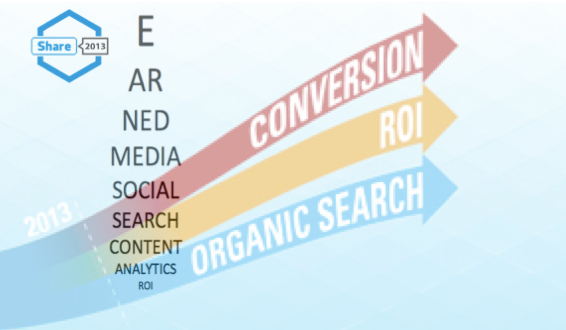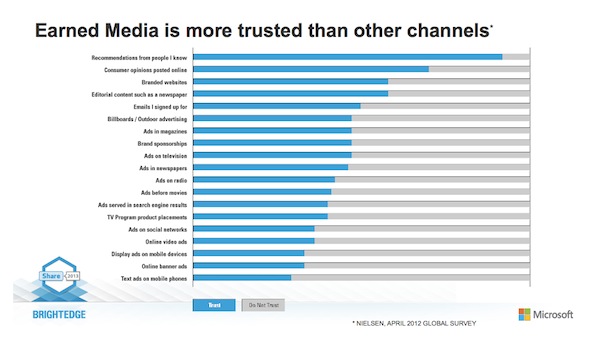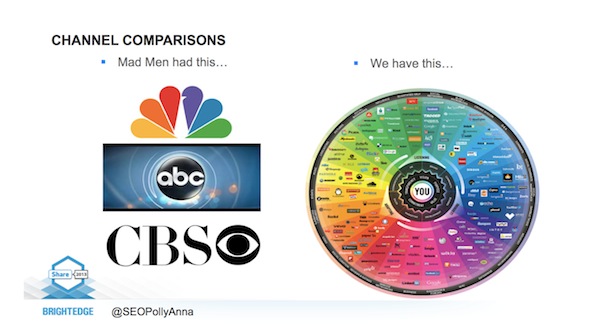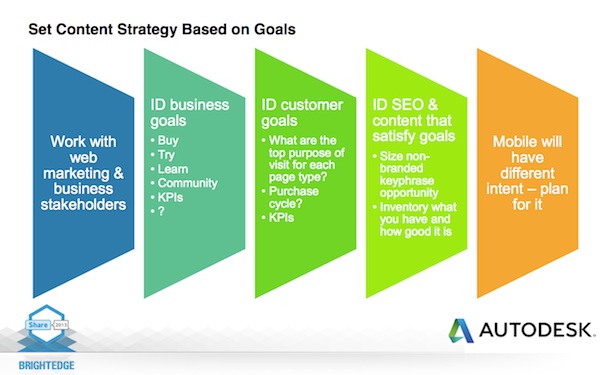
More than 600 senior marketers, 42 speakers, and search and social titans from Google, Google+, Microsoft, Bing, Facebook, Salesforce, and Gap came together last week at the BrightEdge Share13 conference. The goal of Share13 was to connect like-minded marketers and brands and hear from “them” about the future of search and the rise of earned media.
Clearly, content has become the catalyst that has driven a dramatic rise in the importance of earned media.
The convergence of social, mobile, and search marketing techniques and technology has provided marketers with a huge spectrum of opportunity to shift the digital mindset to embrace change and manage their marketing campaigns more efficiently.
Here is a collection of notes, quotes, and insights from leading brands and thought leaders in the earned media and digital marketing space.
1. The Rise of Earned Media
Abe Thomas, General Manager, Microsoft
- Earned, owned, and paid media lines are blurring.
- Old model: hub and spoke.
- New model: converged media.
- With paid media, you get what you paid for.
- Earned media is more trusted than any other channel.

View the presentation here:
2. The Future of Search
Mobile
Eric Papczun, President, Performics
- Mobile accessibility is transforming search.
- In 2015 mobile local search volume will surpass desktop local search for the first time.
- By 2016 we expect mobile to exceed desktop by 27.8 billion queries.
View the presentation here:
Attribution and Content
Jim Brigden, Chief Client Officer, iProspect UK
- We are living through a successful marketing revolution.
- We live in a three-device world – leading to attribution and content iteration challenges.
- Matching content with device is a challenge.
View the presentation here:
3. The Digital CMO
Mike Grehan, Group Publishing Director Interactive Marketing at Incisive Media
- CMOs used to try to shape customers’ desires; now they’re actually learning how to predict them.
- They are spending more and more time on “who we are” and not just “what we sell,” giving their firms a new degree of social intelligence.
- Connect social media data, transaction data and other information to paint a more vivid picture of each customer to generate new ideas about whom to serve and how to best serve that person.
- By 2017, CMOs will spend more on IT than CIOs.
4. The Digital CMO Challenge
Jeremy Sanchez, CEO, Global Strategies
Top five CMO challenges:
- Articulating the value of digital to the CMO.
- Measuring the collateral impact of search.
- Demonstrating innovation and big ideas.
- Actioning strategic insights and dealing with a lack of resources.
- Making search sexy – getting the CMO to lean forward.
It is critical that you know how your CMO is thinking in terms of both a measurement framework and marketing mix.
View the presentation here:
5. Global and Mobile SEO
Dave Lloyd, AdobeSenior Manager, Global Search Marketing
- In data analysis, 90 percent of the analysis takes 90 percent of the time. The last 10 percent takes the other 90 percent of the time.
- Ask yourself why do visitors (mobile and global) come to your site? What task are they trying to accomplish?
- You need a content-rich website responsive to customer needs, regardless of where or how people get there.
- Optimize your global teams to focus on SEO signals.
- Localizations matters more than translation. It’s important to consider culture and context.

View the presentation here:
6. Quality Content Marketing at Scale
Julia Gause, Director, Search Marketing, Scripps Network
To create content at scale, strategy starts with research done by the SEO department:
- Google AdWords, Hitwise, Google Trends/Insights, Yahoo.
- Identify new site’s most important topics, related to the content objective and audience research.
- Use multiple research tools to break down the umbrella topics to find what the online audience really wants.
- Maximize engagement in areas already getting SEO traffic.
- Reinvigorate areas of site that are high priorities for natural search traffic.
- In Scripps case, this means further SEO at the page level.
7. Enterprise Content Marketing & Audience Reach
Michael Kirchhoff, Director of SEO/Product Support, Penwell
Content drives the business.
The combination of the content vision and goals + detailed scope of activities to achieve the goals = Content Strategy Formation
Three steps to take:
- Set measurable goals.
- Audit current performance.
- Create/execute enterprise content marketing plan.
Key action points:
- Organize and align your content with audience behavior and interactions in mind.
- Create quality, optimized content to improve lifecycle and reach.
- Display content leveraging semantics/relationships to increase CTR.
- Promote content to existing audiences leveraging your network, while attracting new audiences.
- Prepare for big data. Utilize what’s available now.
8. Search Forecasting and Business Impact
Ken Shults, Managing Director, Global Strategies with Laura-Ann Mitchell, SEO Manager, Intel
Natural search to Intel.com increased by more than 20 percent per year since establishing a centrally managed SEO program.
Opportunity assessment – a five-step framework:
- Start with grouping keywords by topic.
- Prioritize relevant topics.
- Drill down to sub topics for identifying opportunities.
- Use paid and natural data integration to uncover further opportunities.
- Devise a course of action.
SEO isn’t something you do. It is what happens when you do everything else right.
9. Social and Search
Lisa Williams, Director, Paid, Owned, Earned Media, Rosetta
Customer engagement comparisons – “Mad Men” vs. marketing today:

- They could count on viewers tuning in.
- Our visitors are inundated (average person exposed to 3,000 advertising messages per day) and they expect seamless experience across channels.
- TV watching has recently been outpaced by digital consumption.
- Customer journey involves multiple platforms and devices, and we can’t choose which channel they consume our content on.
What to do today in search and social:
- Redefine your message:
- Integrate content, search, branding and social.
- 70/20/10.
- Redefine how you execute:
- Siloed teams get us siloed messaging.
- Content (words, images, video) is the mission critical asset that binds.
- Redefine ROI:
- Agree to create strategy first, channel second.
- Acknowledge that search-discovery happens on more than just search engines (social networks, other devices, whereverconsumers choose to consume your content).
- Acknowledge that if customers are in a channel you should be there too.
- Acknowledge metrics are more complex and not just transactional.
- Recalibrate expectations on measurement:
- Search-discovery isn’t PPC/paid.
- Search and social impact each other.
- Search-discovery is an investment (owned and earned).
Integrate great storytelling and content strategy in multiple marketing channels and on multiple devices with realistic measuring to meet our challenge of the seamless customer journey and business success.
View the presentation here:
10. Metrics and Analytics That Matter – Big Data
Steve Krull, CEO & Co-Founder, Be Found Online
Money is one metric we can all agree on.
Big data can be overwhelming – 45 percent of marketing execs feel they lack the capacity to put big data to work, according to Lyris/The Economist Intelligence Unit.
Planning the outcome defines the output:
- Fix your analytics.
- Plan to profit.
- “Ready, Fire, Aim” might work sometimes, but “Ready, Aim, Fire” wins much more of the time.
- Your metrics matter – as does perspective.
- What matters are metrics that matter to you – define them early.
- Make sense of the data you have before embarking on the latest and greatest.
- Aggregate Information.
- Organize the data you need to make decisions (in this order): the business, the site, the channel, the campaign.
- CRMs and marketing automation tools can be wonderful, but so can analytics and even spreadsheets.
- Define the job before you decide the tool.

View the presentation here:
11. Adapting SEO Metrics to SERP Changes
Melissa Walner, Director, Global SEO, Hilton Worldwide
Each year, Google changes its search algorithm around 500-600 times, including updates to SERP layouts. SEO best practices and metrics must be adjusted accordingly.
- Panda.
- Penguin.
- Domain clustering.
- Authority boost.
- Local carousel.
Key takeaways:
- The SERPs change constantly, so best practices and metrics must remain flexible.
- Shift the focus away from strictly looking at ranking reports.
- Always be looking ahead for the next big thing and how you can incorporate that into your KPIs in the future.
- Take a holistic approach to analysis. All KPIs are interrelated in some fashion. Go broad and look at as many applicable metrics as possible.

View the presentation here:
12. Metrics that Drive SEO Engagement
Kirill Kronrod, SEO Manager, Adobe Systems
Key metrics:
- Data-driven SEO engagement.
- Reporting to communicate impact.
- Metrics that drive effective strategy.
- Search impact lifecycle.
Avoid common mistakes:
- Making decisions based on a small data sample.
- Analyzing too much data (analysis paralysis).
- Working with biased data (i.e. seasonal trends).
View the presentation here:
13. Bringing it All Together – A Search and Earned Media Case Study
Marty Muse, VP, Client Solutions & Success, DigitalRelevance and David Whitworth, SEO Manager, Rackspace
DigitalRelevance and Rackspace increased organic traffic by 212 percent by utilizing search and earned media.

Key findings:
- The bigger the brand, the tougher it is to maintain agility.
- It takes a lot of pushing to move the needle.
- Technology, people, relationships, and process equal success.
You can download the full case study here.
14. Bringing it All Together – Search and Earned Media
Patrick Brown, Principal, Marketing Analytics, Adobe Systems, Inc. & Jay Middleton, Director, Global Search Marketing, Adobe Systems Inc.
The five principles guiding our path to bringing search and earned media together:
- Focus on key business questions: Business strategy and objectives drive all downstream activity.
- Take time to build the foundation: Develop the raw data foundation, understand business logic.
- Break down the silos: Organizational changes = alignment and speed to market.
- Establish clear governance models: “1 Source of Truth” – Single ownership of customer data segments.
- Bring it all together: Big Data + Creativity + Communication = Customer Success.
View the presentation here:
15. Aligning Content and SEO
Robin Francis, Senior Manager, Search/Web, Autodesk
Great content helps:
- Visitors become prospects.
- Prospects become customers.
- Customers become loyal fans (but not if the content is confusing or fragmented.
The average customer is 57 percent of the way through the decision-making process before engaging sales.

- Infuse design with content strategy plus SEO.
- Ensure code benefits SEO plus content strategy.
- Evangelize with stakeholders on what’s coming.
- Coordinate content with search engines in mind.
- Translate and localize for global visibility.
- Syndicate the right content.
- Analyze, test, and iterate!
- Evangelizehow it went.
- Govern your content for the long term.
View the presentation here:
16. Creating Content for Humans
Holland Dauterive, SEO Manager, ModCloth
We create content to sell and figure out what to sell. Create for customers not for spiders.
- Don’t just write about tangentially-related topics because they have high keyword volume.
- What are people asking customer care about?
- Common questions are great content ideas.
- Help increase you visibility and decreases workload for the customer care team.
- What are people posting about on Facebook, Twitter, Pinterest, etc.?
- This can guide both content as well as your merchants.
- Know when to optimize and when not to “over optimize.”

View the presentation here:
17. Webmaster Tools and White Hat Practices
Vincent Wehren, Bing Webmaster Tools Senior Programs Manager, Microsoft
Bing and Yahoo combined search share is 29.2 percent, according to comScore. Butalso add Facebook web search and Windows smart search to the equation.
Bing is so much more than just Bing.com.
- Bing Webmaster Tools are the place to provide information to Bing:
- Submit sitemaps, URLs.
- Control visibility of your pages.
- Parameters to ignore.
- Crawl speed.
- Bing Webmaster Tools are the place to get information from Bing:
- Reports and data.
- Traffic, keywords, links, etc.
- Bing Webmaster Tools provides a multitude of additional indispensable tools:
- SEO Analyzer.
- Fetch as Bingbot.
- Malware Re-Evaluation.
- Site Move.
- Alerts & Notifications.
18. Loving Links Beyond SEO
Mel Carson, Majestic SEO and Delightful Communications
Links are about relationships.

Majestic SEO and link data isn’t just for SEO. It’s also for:
- Influencer discovery.
- Digital PR.
- Spotting commercial opportunities.
- Uncovering geographic deficiencies.
- Predicting stuff.
View the presentation here:
19. The Social Business Transformation
Todd Wilms, Head of Social Strategy, SAP
The definition of a social business:
“Activities that use social media, social software, and social networks to enable the more efficient, effective, and mutually useful connection between people, information, and assets. These connections can drive business decisions, actions, and outcomes across the enterprise.”
MIT SLOAN SCHOOL OF MANAGEMENT
- Social business is the transformation to align social with business outcomes.
- Social business starts with business objectives.
- Start where you need it most, based on the values of your organization.

- Social business should enhance your company culture, not swim against it.
- Don’t get caught in the ROI argument – no one wins.
- “When an executive asks for ROI, what they mean is ‘reassure me.'”
Ensure that you:
- Research: Support with facts/factoids along the way.
- Develop: Strategy tailored for your business.
- Decide: Risk tolerance.
View the presentation here:
20. Mobile and SEO

Mike Grehan, Group Publishing Director Interactive Marketing at Incisive Media
Eighty-seven percent of marketers plan to increase emphasis on mobile.
Chris Birkholm, Program Manager, Digital River
Only six of the Top 100 Fortune 500 companies meet Google mobile requirements.
BrightEdge evaluated the growth of mobile as compared to desktop from H1 2012 to H1 2013.
- Mobile traffic grew 10 times faster than desktop: From H1 2012 to H1 2013, mobile traffic grew 125 percent while desktop grew a mere 12 percent.
- Software/Technology, Financial Services and Real Estate lead mobile traffic:These industries experienced significant growth in mobile traffic when compared to desktop.
- Mobile conversions lag behind tablet and desktop: Tablet and desktop have nearly the same conversion rate. Mobile converts at a significantly lower rate: 0.3x desktop and tablet.
- Video content drives conversions: Mass video consumption within the media and entertainment industry drives mobile conversions at a rate that exceeds desktop conversions: 1.6x. Other industries that convert relatively well on mobile include travel and hospitality at a rate of .7x desktop and e-commerce at a rate of .6x desktop.
Jessica Lee from SEW explains in more detail in “Mobile Traffic Up 125% but Conversions Lag Behind Desktop [Study]“.
End Notes
The amount of content and insight exchanged at Share13 was quite staggering ¬– far too much for me to do it all justice in one post, as this has only captured half the speakers.
Next week is SES San Francisco, I hope to continue sharing insights in a similar format from some of key sessions, key brands and key speakers. Once again the line up looks stellar and I hope to see you there. If you are a brand that would look like to help share further insights with me and SEW then let’s grab a coffee at the event.











